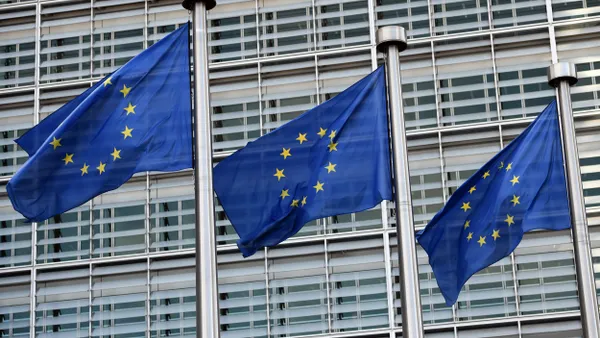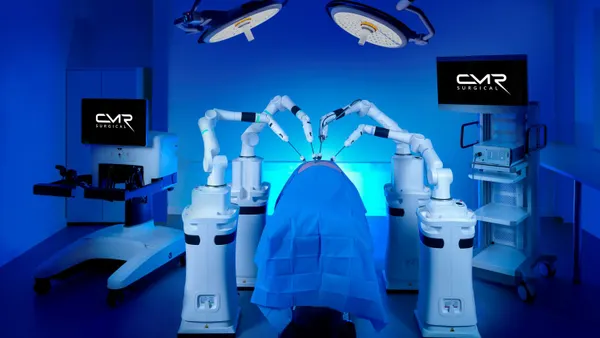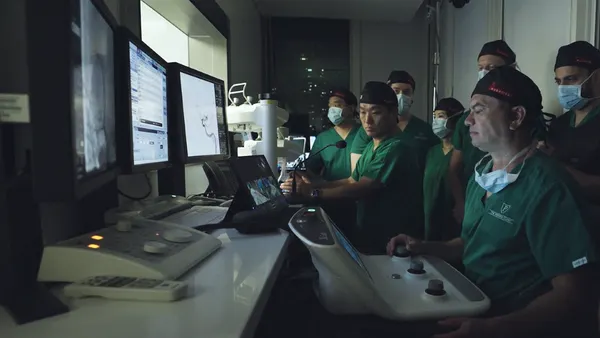Dive Brief:
- Continuous glucose monitor maker Dexcom's revenue grew 49% to $396.3 million in the third quarter, with a three-year high in U.S. revenue growth for the business, the company reported Wednesday. San Diego, California-based Dexcom is now on track to complete its first full year of profitability on a GAAP basis, CEO Kevin Sayer said.
-
The focus on improving margins comes at a critical time, the team at Jefferies said. "Cost reduction is of paramount importance because whether as a direct result of competition or adoption into more cost-conscious markets, CGM prices will likely trend downward indefinitely," the analysts wrote in a note to investors following Dexcom's earnings call.
- Potentially insufficient manufacturing capacity presents the greatest threat to momentum. Dexcom revealed one of its automated G6 sensor production lines temporarily had problems late last quarter, leaving inventory levels "tight" into the fourth quarter. "As a result, the remaining transition from G5 to G6 for certain channels of our business will be slower than originally anticipated," CFO Quentin Blackford said.
Dive Insight:
Shares in Dexcom jumped 28% in early trading Thursday on what numerous sell-side analysts called "blowout" third quarter results with few signs of slowdown.
U.S. revenue, clocking in at $308.8 million, hit its highest growth since the first quarter of 2016. And international revenue of $87.5 million, helped by the launch of G6 in Canada during the quarter, also supported the beat-and-raise period, growing 36% year over year and almost 25% sequentially.
Of the many catalysts supporting Dexcom's growth — such as increasing awareness of CGM and greater product adoption within the Medicare population and through the pharmacy channel — Sayer said the biggest driver during the third quarter was growth within the U.S. commercial patient sector.
Traction elsewhere in the diabetes tech market, including the expected launches of Tandem's Control-IQ algorithm and Insulet's Omnipod hybrid closed loop system within the next year, could help Dexcom win more consumers interested in automated insulin delivery.
Wall Street was bullish on the outlook.
"Long story short, with revenue growth coming in 50% faster in the quarter than we expected on exceptional patient demand and no slowdown in sight, the company has the equivalent of a global tiger by the tail," analysts at William Blair said in a note to investors following the results. "In our opinion, market conversion is no longer a question of if but how fast."
The team at Cowen sounded a similar note.
"We continue to have conviction that adoption amongst the non-intensive Type 2 patients population is a question of when, not if," the analysts wrote.
Sayer highlighted investment in Dexcom's new markets team, which he said is gathering data on "markets to pursue outside of our core intensive insulin business," such as pregnant women and people with non-intensively managed Type 2 diabetes or prediabetes.
But Dexcom still has work to do in boosting reimbursement in its existing rings such as the intensively managed Type 2 market.
"Medicare covers those patients and some of the payers have come along and some of them have not. We think it will continue to grow over time," Sayer said. "But even with our pharmacy contracts, there are sometimes limitations as to what insulin using patients can have access to our technology. We are negotiating through that."
Sayer said Dexcom expects adoption within the Medicare population to "really take off" next year as those patients will be able to access supplies at Walgreens.
The company is increasingly starting new users through pharmacies and is confident the lower-cost channel will pay off. "We firmly believe that we can make more profit dollars per patient through the pharmacy channel than we can through the DME channel," Blackford said.
Being prepared to meet product demand is another top priority. CEO Kevin Sayer acknowledged manufacturing pressures.
"This explosive growth continues to leave supply levels much tighter than we expected as we ramp capacity and because of these supply constraints, our customer facing infrastructure has been stretched to its limits," Sayer told investors.
The company said it is on track to meet its goal of doubling G6 manufacturing capacity by year's end. With more automated lines set to begin work in the first quarter, Dexcom will again have doubled capacity by mid-2020, he said.
Dexcom may see new competition with the seemingly imminent, albeit behind schedule, FDA approval of Abbott's FreeStyle Libre 2. Abbott executives said on an October earnings call regulatory review has taken longer than expected.
Analysts at Cowen downplayed the impact of that product launch on Dexcom, saying the next-generation device will likely improve Abbott's competitive position but will not surpass the reliability and accuracy of G6.
"Abbott has also talked of significantly increasing its advertising presence in 2020 — this is music to our ears, as it should only further increase awareness and overall CGM adoption (helping DXCM, just as it has ever since Libre first launched)," analysts at Cowen wrote.
Dexcom reaffirmed its target to begin a limited launch of the smaller G7 model late next year with plans to expand that rollout in 2021 and make G7 its primary offering. G6 gained FDA authorization in 2018, superseding the G5, which got the U.S. market go-ahead in 2015.
Even taking into account an at least $100 million pricing headwind related to competitive pricing pressure and potentially lower revenues from the Medicare and pharmacy channels, Dexcom again raised guidance. The company now forecasts full-year revenues to be between $1.425 billion and $1.45 billion, or 38% to 41% growth, up from a previous target of 28% to 33% growth.












